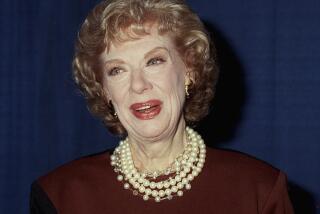An appreciation: Jill Clayburgh
There is a classic Jill Clayburgh scene in Paul Mazursky’s “An Unmarried Woman,” the 1978 film the actress will be remembered for most in a career that kept her busy with work nearly until her death on Friday. She’s walking down a crowded New York City sidewalk having just learned her husband is leaving her for someone half her age, the fresh wound visible only in those eyes, a soft cornflower blue gone stone cold.
She stops to steady herself, throws up, shakes it off, then moves on. Clayburgh had a way of making moments like these so real she would break my heart. Her portrayal of the affluent, urban, urbane Erica would earn her an Oscar nomination.
Women like that became, in a sense, Clayburgh women. They were flawed, vulnerable, feisty, funny, sometimes steely and always smart. They were a better, more beautiful version of what many of us wanted to be, but only slightly. Like everything else about Clayburgh, her beauty was subtle, never showy. It’s why she could pull off dowdy in “Starting Over,” the 1979 film that would bring a second Oscar nod. As an elementary school teacher and the new love interest for Burt Reynolds’ divorcing writer, she’s a plainer Jane forced to compete for his affections with his ex, the luminous Candice Bergen.
For all the darker, conflicted roles she would play through the years, Clayburgh had a great sense of comic timing. As the brassy Carole Lombard in 1976’s “Gable & Lombard” with James Brolin, she was charming as the outspoken young actress willing to risk fame for the man she loved. It was her first starring role after years of minor ones that kept her shifting between stage, TV and film, a pattern she would continue. It would be opposite Gene Wilder in “Silver Streak” later that year that she would cement her comedy chops — proving what lightheaded fun understatement could be against Wilder’s over the top.
Clayburgh had a way of classing up whatever project she was involved with, a studied intelligence, a natural grace. Though the projects might fail her, and many of them did, she rarely failed them. As a fictional Supreme Court justice breaking into that all-male bastion in “First Monday in October,” she was brilliant turning congressional hearings into a cerebral tennis match that she won without breaking a sweat. In portraying actress Jill Ireland’s battle against breast cancer in “Reason for Living,” she was able to elevate an otherwise forgettable TV film, although it would take her death to realize that perhaps she took the project on because it came not long after she learned about her leukemia, a 21-year struggle she chose to keep in the shadows. Like Ireland, she never wanted to play the victim.
Some of her best film work went almost unnoticed. For example, as a young widow in an incestuous relationship with her teenaged son in Bernardo Bertolucci’s “Luna,” somehow she made the unthinkable understandable. And her heart was never more on her sleeve than in “I’m Dancing as Fast as I Can.” Written by her husband, playwright David Rabe, the 1982 film is based on Barbara Gordon’s chilling memoir of that deadly cocktail of stress, ambition, Valium and controlling men. Clayburgh traded subtlety for searing, a choice many found too unnerving at the time. Perhaps because we’re more accustomed to high-end meltdowns now, it proves better with age.
In time, the film roles would shrink, the roles downsized, more around the edges, like the psychiatrist’s kibble-snacking, couch potato wife in “Running With Scissors.” Like many actresses of a certain age, she would find juicier roles on television. In her recent stint as Tish, a nearly perfectly embodied New York socialite and matriarch of “Dirty Sexy Money’s” uber-rich clan of misfits, it seemed as if she had a found a home, at least until the drama’s cancellation in spring ’09.
She will be seen in two more films, including “Love & Other Drugs” this month. And no doubt she will do her usual well-crafted job. But “An Unmarried Woman” will be the one that stays with me. One of my favorite scenes comes late in the film as she is still finding her way in her newly single life. Again the street is crowded, so much so that even other New Yorkers heed the “Don’t Walk” sign. But she strides through — without a second glance, without fear — facing whatever the future holds.
More to Read
The biggest entertainment stories
Get our big stories about Hollywood, film, television, music, arts, culture and more right in your inbox as soon as they publish.
You may occasionally receive promotional content from the Los Angeles Times.







